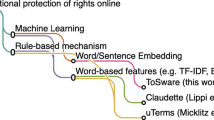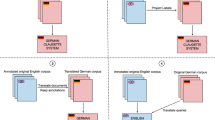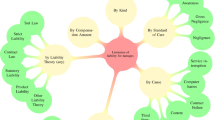Abstract
Terms of service of on-line platforms too often contain clauses that are potentially unfair to the consumer. We present an experimental study where machine learning is employed to automatically detect such potentially unfair clauses. Results show that the proposed system could provide a valuable tool for lawyers and consumers alike.



Similar content being viewed by others
Notes
See the Council Directive 93/13/EEC on Unfair Terms in Consumer Contracts, art. 3.1.
We remark that, from the point of view of natural language processing, we are handling a pure sentence classification task, as we detect full statements and not directly single clauses.
In particular, we selected the ToS offered by: 9gag.com, Academia.edu, Airbnb, Amazon, Atlas Solutions, Betterpoints, Booking.com, Crowdtangle, Deliveroo, Dropbox, Duolingo, eBay, Endomondo, Evernote, Facebook, Fitbit, Google, Headspace, Instagram, Linden Lab, LinkedIn, Masquerade, Microsoft, Moves-app, musically, Netflix, Nintendo, Oculus, Onavo, Pokemon GO, Rovio, Skype, Skyscanner, Snapchat, Spotify, Supercell, SyncMe, Tinder, TripAdvisor, TrueCaller, Twitter, Uber, Viber, Vimeo, Vivino, WhatsApp, World of Warcraft, Yahoo, YouTube and Zynga.
Segmentation into sentences was made using the Stanford CoreNLP suite (see Sect. 5).
In particular, we selected the ToS offered by: Alibaba, Badoo, Goodreads, Groupon, Mozilla, Ryanair, Shazam, Slack, Zalando UK, eDreams.
Sampling takes into account the class distribution in the training set.
References
Aletras N, Tsarapatsanis D, Preoiuc-Pietro D, Lampos V (2016) Predicting judicial decisions of the European Court of Human Rights: a natural language processing perspective. PeerJ Comput Sci 2:e93
Ashley K (2017) Artificial intelligence and legal analytics: new tools for law practice in the digital age. Cambridge University Press, Cambridge
Ashley KD, Walker VR (2013) Toward constructing evidence-based legal arguments using legal decision documents and machine learning. In: Francesconi E, Verheij B (eds) ICAIL 2012, Rome, Italy, ACM, pp 176–180. https://doi.org/10.1145/2514601.2514622. http://dl.acm.org/citation.cfm?id=2514622
Bakos Y, Marotta-Wurgler F, Trossen DR (2014) Does anyone read the fine print? Consumer attention to standard-form contracts. J Legal Stud 43(1):1–35
Bartolini C, Giurgiu A, Lenzini G, Robaldo L (2016) Towards legal compliance by correlating standards and laws with a semi-automated methodology. In: BNCAI, Communications in computer and information science, vol 765. Springer, pp 47–62
Biagioli C, Francesconi E, Passerini A, Montemagni S, Soria C (2005) Automatic semantics extraction in law documents. In: Proceedings of ICAIL, ACM, pp 133–140
Cohen J (1968) Weighted kappa: nominal scale agreement provision for scaled disagreement or partial credit. Psychol Bull 70(4):213
Collins M, Duffy N (2002) New ranking algorithms for parsing and tagging: kernels over discrete structures, and the voted perceptron. In: Proceedings of the 40th annual meeting of the ACL, ACL, pp 263–270
Department of Commerce (2010) Commercial data privacy and innovation in the internet economy: a dynamic policy framework. Technical report, Department of Commerce Internet Policy Task Force. https://www.ntia.doc.gov/files/ntia/publications/iptf_privacy_greenpaper_12162010.pdf
Fabian B, Ermakova T, Lentz T (2017) Large-scale readability analysis of privacy policies. In: Proceedings of the international conference on web intelligence, ACM, pp 18–25
Graves A, Schmidhuber J (2005) Framewise phoneme classification with bidirectional lstm and other neural network architectures. Neural Netw 18(5):602–610
Habernal I, Gurevych I (2017) Argumentation mining in user-generated web discourse. Comput Linguist 43(1):125–179
Harkous H, Fawaz K, Lebret R, Schaub F, Shin KG, Aberer K (2018) Polisis: automated analysis and presentation of privacy policies using deep learning. arXiv:180202561
Joachims T (1998) Text categorization with support vector machines: Learning with many relevant features. In: ECML, vol 98, pp 137–142
Kim Y (2014) Convolutional neural networks for sentence classification. In: Moschitti A, Pang B, Daelemans W (eds) Proceedings of the 2014 conference on empirical methods in natural language processing, EMNLP 2014, October 25–29, 2014, Doha, Qatar, A meeting of SIGDAT, a special interest group of the ACL, ACL, pp 1746–1751
Landis JR, Koch GG (1977) The measurement of observer agreement for categorical data. Biometrics 33(1):159–174
Leopold E, Kindermann J (2002) Text categorization with support vector machines. How to represent texts in input space? Mach Learn 46(1–3):423–444
Lippi M, Torroni P (2016a) Argumentation mining: state of the art and emerging trends. ACM Trans Internet Technol 16(2):10:1–10:25
Lippi M, Torroni P (2016b) Margot: a web server for argumentation mining. Expert Syst Appl 65(C):292–303. https://doi.org/10.1016/j.eswa.2016.08.050
Lippi M, Palka P, Contissa G, Lagioia F, Micklitz H, Panagis Y, Sartor G, Torroni P (2017) Automated detection of unfair clauses in online consumer contracts. In: Wyner AZ, Casini G (eds) Legal knowledge and information systems—JURIX 2017: the thirtieth annual conference, vol 302, Luxembourg, 13–15 December 2017, IOS Press, Frontiers in Artificial Intelligence and Applications, pp 145–154
Lippi M, Lagioia F, Contissa G, Sartor G, Torroni P (2018) Claim detection in judgments of the EU Court of Justice. In: Artificial intelligence and the complexity of legal systems, VI international workshop (AICOL), selected revised papers. Lecture notes in artificial intelligence, Springer, forthcoming
Loos M, Luzak J (2016) Wanted: a bigger stick. On unfair terms in consumer contracts with online service providers. J Consum Policy 39(1):63–90
McDonald A, Cranor L (2008) The cost of reading privacy policies. I/S J Law Policy Inf Soc 4(3):543–568
Micklitz HW, Reich N (2014) The court and sleeping beauty: the revival of the unfair contract terms directive (UCTD). Common Market Law Rev 51(3):771–808
Micklitz HW, Pałka P, Panagis Y (2017) The empire strikes back: digital control of unfair terms of online services. J Consum Policy 40(3):367–388
Mikolov T, Chen K, Corrado G, Dean J (2013) Efficient estimation of word representations in vector space. arxiv: 1301.3781
Moens MF, Boiy E, Palau RM, Reed C (2007) Automatic detection of arguments in legal texts. In: Proceedings of the 11th international conference on artificial intelligence and law, ACM, pp 225–230
Moschitti A (2006) Efficient convolution kernels for dependency and constituent syntactic trees. In: Fürnkranz J, Scheffer T, Spiliopoulou M (eds) Machine learning: ECML 2006, LNCS, vol 4212. Springer, Berlin Heidelberg, pp 318–329
Nebbia P (2007) Unfair contract terms in European law: a study in comparative and EC law. Bloomsbury Publishing, London
Obar JA, Oeldorf-Hirsch A (2016) The biggest lie on the internet: ignoring the privacy policies and terms of service policies of social networking services. In: TPRC 44: the 44th research conference on communication, information and internet policy
Reich N, Micklitz HW, Rott P, Tonner K (2014) European consumer law. Intersentia, Cambridge
Robaldo L, Sun X (2017) Reified input/output logic: combining input/output logic and reification to represent norms coming from existing legislation. J Logic Comput 27(8):2471–2503
Schulte-Nölke H, Twigg-Flesner C, Ebers M (2008) EC consumer law compendium: the consumer acquis and its transposition in the member states. Walter de Gruyter, Berlin
Sebastiani F (2002) Machine learning in automated text categorization. ACM Comput Surv 34(1):1–47. https://doi.org/10.1145/505282.505283
Shulayeva O, Siddharthan A, Wyner A (2017) Recognizing cited facts and principles in legal judgements. Artif Intell Law 25(1):107–126
Tsochantaridis I, Joachims T, Hofmann T, Altun Y (2005) Large margin methods for structured and interdependent output variables. J Mach Learn Res 6:1453–1484
Acknowledgements
Funding was obtained from European University Institute by author Hans-Wolfgang Micklitz (CLAUDETTE Project).
Author information
Authors and Affiliations
Corresponding author
Additional information
Publisher's Note
Springer Nature remains neutral with regard to jurisdictional claims in published maps and institutional affiliations.
Rights and permissions
About this article
Cite this article
Lippi, M., Pałka, P., Contissa, G. et al. CLAUDETTE: an automated detector of potentially unfair clauses in online terms of service. Artif Intell Law 27, 117–139 (2019). https://doi.org/10.1007/s10506-019-09243-2
Published:
Issue Date:
DOI: https://doi.org/10.1007/s10506-019-09243-2




